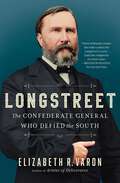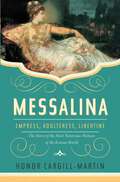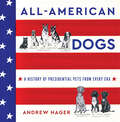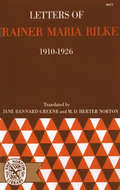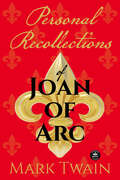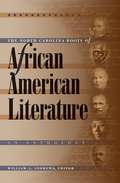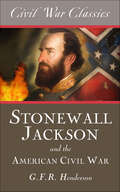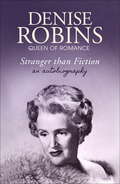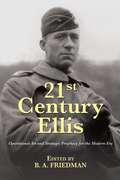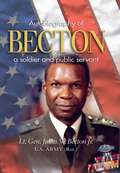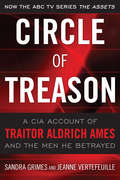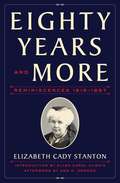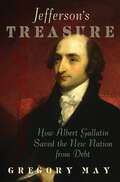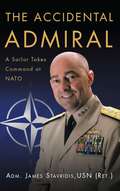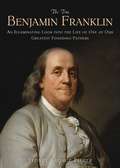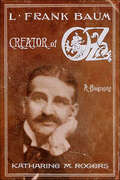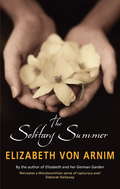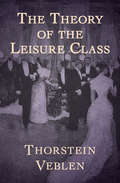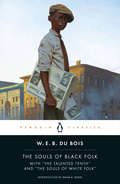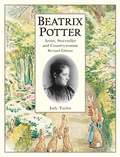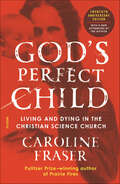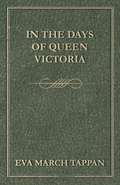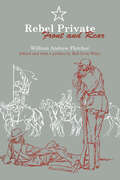- Table View
- List View
Longstreet: The Confederate General Who Defied the South
by Elizabeth VaronFinalist, Los Angeles Times Book Prize for Biography American Battlefield Trust Prize for History Finalist A &“compelling portrait&” (Jon Meacham, Pulitzer Prize–winning author) of the controversial Confederate general who later embraced Reconstruction and became an outcast in the South. It was the most remarkable political about-face in American history. During the Civil War, General James Longstreet fought tenaciously for the Confederacy. He was alongside Lee at Gettysburg (and counseled him not to order the ill-fated attacks on entrenched Union forces there). He won a major Confederate victory at Chickamauga and was seriously wounded during a later battle. After the war, Longstreet moved to New Orleans, where he dramatically changed course. He supported Black voting and joined the newly elected, integrated postwar government in Louisiana. When white supremacists took up arms to oust that government, Longstreet, leading the interracial state militia, did battle against former Confederates. His defiance ignited a firestorm of controversy, as white Southerners branded him a race traitor and blamed him retroactively for the South&’s defeat in the Civil War. Although he was one of the highest-ranking Confederate generals, Longstreet has never been commemorated with statues or other memorials in the South because of his postwar actions in rejecting the Lost Cause mythology and urging racial reconciliation. He is being discovered in the new age of racial reckoning as &“one of the most enduringly relevant voices in American history&” (The Wall Street Journal). This is the first authoritative biography in decades and the first that &“brilliantly creates the wider context for Longstreet&’s career&” (The New York Times).
Messalina: Empress, Adulteress, Libertine: The Story of the Most Notorious Woman of the Roman World
by Honor Cargill-MartinThe shocking and scandalous story of Messalina—the third wife of Emperor Claudius—one of the most controversial women to have inhabited the Roman world.The lubricious image of the Empress Messalina as a ruthless, predatory, and sexually insatiable schemer—derived from the work of male historians such as Tacitus and Suetonius—has taken deep root in the Western imagination. Here, the classicist Honor Cargill-Martin puts this traditional narrative of Messalina to the test. She looks first at Messalina's life as it is recounted in the primary sources, before using material and circumstantial evidence to reconstruct each aspect of Messalina's character: politician, wife, adulteress, and prostitute. Finally, she explores how posterity has memorialized Messalina, whether as artist's muse, epitome of depraved pagan womanhood, or as libertine icon portrayed in literature and film. Cargill-Martin sets out not to entirely rewrite Messalina's history, or to salvage her reputation, but to look at her life in the context of her time and to reclaim the humanity of a life story previously defined by currents of high politics and patriarchy.
All-American Dogs: A History of Presidential Pets from Every Era
by Andrew HagerFrom historian-in-residence at the Presidential Pet Museum, Andrew Hager, comes a fond, fascinating, and often surprising look at the dogs who were the best friends of the presidents, featuring unforgettable photographs.President Biden’s German shepherds, Major and the late Champ, are the latest in a long line of presidential dogs. Dating all the way back to George Washington, dogs have been constant companions to nearly all of America’s presidents. Of the past 46 presidents, 31 have had at least one dog at 1600 Pennsylvania Ave.Organized by historical eras, All-American Dogs will take readers through the captivating history of the White House’s four-legged friends, the impact they had on their owner-in-chiefs, and, ultimately, American history. From the assassination of President’s Lincoln’s dog after Lincoln’s own death to President’s Hoover’s Belgian shepherd, King Tut, who helped President Hoover win the election after appearing in a campaign photo, these furry members of the first family often had a lasting impact on the administrations that kept them.As historian-in-residence at the Presidential Pet Museum, Andrew Hager will include original research and rare photographs from the National Archives to trace the history of America’s first dogs. From post-Revolutionary dogs, to Civil War era dogs, to Cold War dogs, Hager will show the differences and similarities of how our nation viewed man’s best friend.Readers will learn not only past presidents’ dogs in each historical era, but also the cultural history of dogs as pets, and the ways in which Americans’ relationships with dogs has evolved over the past two centuries.
Letters of Rainer Maria Rilke, 1910-1926
by Rainer Maria Rilke M. D. Norton Jane Bannard GreeneThis volume of Rilke's letters covers the years from the completion of The Notebooks of Malte Laurids Brigge to Rilke's death in December 1926, nearly five years after he had written the Duino Elegies and the Sonnets to Orpheus, his last major works. There are important letters here to Muzot, Lou Andreas-Salome, to Princess Marie of Thurn and Taxis Hohenlohe, and many others. The most significant of the Wartime Letters: 1914-1921 are also included. An Introduction briefly traces the development of Rilke's work during these years; the Notes provide the necessary framework of biographical details and point up significant references to the poetry.
Personal Recollections of Joan of Arc: And Other Tributes to the Maid of Orlv©ans
by Mark TwainA novel of the life of the defender of medieval France by the celebrated author of Adventures of Huckleberry Finn. She saved France when she was fourteen . . . She was burned at the stake for her efforts . . . Meet the girl who captured Mark Twain&’s heart. A forgotten masterpiece from one of America&’s greatest authors—and the last full-length novel he ever wrote—Joan of Arc follows the Savior of France from her childhood in Domrémy, to her campaigns throughout the French countryside, to her demise at the hands of the English and Burgundians. Mark Twain was sarcastic, witty, and oft-irreverent, but he had a soft spot for the Maid of Orléans. (As will you after you read this book!) He spent twelve years in research, two in writing, including multiple visits to the National Archives in Paris, and proclaimed Joan of Arc the &“best of all my books!&” If you love well-written classics of stunning historical figures, then this is the book for you.
The North Carolina Roots of African American Literature
by William L. AndrewsThe first African American to publish a book in the South, the author of the first female slave narrative in the United States, the father of black nationalism in America--these and other founders of African American literature have a surprising connection to one another: they all hailed from the state of North Carolina.This collection of poetry, fiction, autobiography, and essays showcases some of the best work of eight influential African American writers from North Carolina during the nineteenth and early twentieth centuries. In his introduction, William L. Andrews explores the reasons why black North Carolinians made such a disproportionate contribution (in quantity and lasting quality) to African American literature as compared to that of other southern states with larger African American populations. The authors in this anthology parlayed both the advantages and disadvantages of their North Carolina beginnings into sophisticated perspectives on the best and the worst of which humanity, in both the South and the North, was capable. They created an African American literary tradition unrivaled by that of any other state in the South. Writers included here are Charles W. Chesnutt, Anna Julia Cooper, David Bryant Fulton, George Moses Horton, Harriet Jacobs, Lunsford Lane, Moses Roper, and David Walker.
Stonewall Jackson and the American Civil War (Civil War Classics)
by G.F.R. HendersonTo commemorate the 150th Anniversary of the end of the Civil War, Diversion Books is publishing seminal works of the era: stories told by the men and women who led, who fought, and who lived in an America that had come apart at the seams. Thomas Jonathan Jackson earned his famous moniker during the Battle of Manassas, when an entire brigade was commanded to rally behind Jackson, whose own company was fighting like a stone wall. One of the finest generals of the Confederacy, Stonewall Jackson played a vital role in the Civil War, and an even more important role in the mythology of the South. This biography of Jackson, written by renowned military historian G.F.R. Henderson, strives to capture not only the man, but the legend that surrounds him to this day.
Stranger than Fiction
by Denise RobinsThe autobiography of Denise Robins, the 100-million-copy bestselling Queen of Romance, first published in 1965, and available now for the first time in eBook. Apart from writing over two hundred novels which have sold over one hundred million copies worldwide, Denise Robins led a remarkable life. Love and romance were always dominant influences and were reflected not only in her work but in her attitude to life. All the warmth, compassion and deep understanding of the frailty if the human heart that shine through her novels, can be seen here in her autobiography. It is a story that will captivate her huge audience of readers.
21st Century Ellis
by Edited by B. A. FriedmanFor years, the Marine Corps has touted the prescience of Lieutenant Colonel "Pete” Ellis, USMC, who predicted in 1921 that the United States would fight Japan and how the Pacific Theater would be won. Now, for the first time, those predictions and other works by the "amphibious prophet” are available in print. Included is two works by Ellis on naval and amphibious operations, including Advanced Base Operations in Micronesia, the study of tactics and operations in the Pacific Ocean that the United States Navy and Marine Corps would use to win the war against Imperial Japan. Ellis describes the form and functions of a modern Marine Corps designed to win its Nation’s battles. Ellis’ ideas about how the Marine Corps should fight are still in use throughout the world today. Ellis’ ideas on amphibious operations are well known, but his ideas on counterinsurgency and conventional war have been overshadowed and forgotten. Ellis wrote two articles based on his warfighting experiences in the Philippines and as part of the American Expeditionary Force in Europe during World War I. These articles, last published in the early 1920’s, are both republished in this book and show Ellis as a prescient thinker who was ahead of his time. Ellis identifies concepts that the U. S. military struggles with even today, and that other thinkers would not identify for decades after Ellis’ death. Also included are six essays by the editor, introducing the ideas of Pete Ellis and putting them in a modern context. As the United States turns its focus to the Pacific, Ellis’ ideas can inform policymakers on the dynamics of strategy and warfare in the vast reaches of the Pacific Ocean. Edited by Captain B. A. Friedman, USMC, 21st Century Ellis reveals the strategic insights of Pete Ellis for then and now.
Becton
by Julius Becton Jr.This autobiography, published in cooperation with the Association of the United States Army (AUSA), highlights Lt. Gen. Becton's remarkable career and reveals the influences that contributed to his success. Becton's autobiography reflects on his youth in the suburban Philadelphia area, his parental and family influences, and his almost forty years of service in the U.S. Army and in subsequent civilian appointments. His devotion to leadership, education, service, race, and his spiritual upbringing are all central themes in the book.After finishing high school, Becton entered a segregated Army at age eighteen and over nearly forty years rose to the rank of lieutenant general. Two years after enlisting in the Army Air Corps Enlisted Reserve, he was commissioned a second lieutenant of infantry and subsequently fought with distinction in the Korean War. Integrated into the Regular Army in 1951, he went on to earn undergraduate and graduate degrees in mathematics and economics and held combat commands in the 101st Airborne Division in Vietnam. He commanded the legendary 1st Cavalry Division in 1975-76. Promoted to lieutenant general in 1978, he served as commanding general of the U.S. VII Corps in Germany and deputy commander of Training and Doctrine Command and the Army Inspector of Training before retiring in 1983.Following retirement he entered fields of international disaster assistance, emergency management, and education. Becton joined the Reagan administration in 1984 as Director of the Office of Foreign Disaster Assistance for the Agency for International Development. From 1985 to 1989 he was Director of the Federal Emergency Management Agency. Over the next six years, he was the COO of American Coastal Industries and president of Prairie View A&M University. His final civilian post was as CEO/Superintendent of public schools in the District of Columbia.Becton was listed several times by Ebony magazine as 'One of the 100 Most Influential Blacks in America.' In 2007 he was selected to receive the George Catlett Marshall Medal, the highest award presented by the Association of the U.S. Army (AUSA) for being a 'soldier, combat commander, administrator, educator, public servant, government leader, and role model.'
Circle of Treason
by Sandra V. Grimes Jeanne VertefeuilleCircle of Treason details the authors' personal involvement in the hunt for and eventual identification of a Soviet mole in the CIA during the 1980s and 1990s. The search for the presumed traitor was necessitated by the loss of almost all of the CIA's large stable of Soviet intelligence officers working for the United States against their homeland. Aldrich Ames, a long-time acquaintance and co-worker of the authors in the Soviet-East European Division and Counterintelligence Center of CIA, turned out to be that mole. In April 1985 Ames walked in to the Soviet Embassy in Washington, D. C. and volunteered to the KGB, working for the Soviet Union for nine years until his arrest by the FBI in February 1994.Ames was arguably one of the most destructive traitors in American history, and is most well-known for providing information which led to the death of at least 11 Soviet intelligence officers who spied for the West. The authors participated in the majority of these cases and the book provides detailed accounts of the operational contact with the agents as well as other similar important cases with which the authors also had personal involvement. The stories of the brave men who were executed or imprisoned by the Soviet Union include GRU General Dmitriy Fedorovich Polyakov, KGB Colonel Leonid Georgiyevich Poleshchuk, KGB Colonel Vladimir Mikhaylovich Piguzov, GRU technical officer Nikolay Chernov, GRU Lieutenant Colonel Boris Nikolayevich Yuzhin, KGB scientific and technical officer Vladimir Ippolitovich Vetrov, GRU Colonel Vladimir Mikhaylovich Vasilyev, GRU officer Gennadiy Aleksandrovich Smetanin, KGB illegals support officer Gennadiy Grigoryevich Varenik, KGB scientific and technical officer Valeriy Fedorovich Martynov, KGB political intelligence officer Sergey Mikhaylovich Motorin, KGB officer Sergey Vorontsov, and Soviet scientist Adolf Grigoryevich Tolkachev. Other operations include KGB technical officer Viktor Ivanovich Sheymov, GRU Colonel Sergey Ivanovich Bokhan, and KGB Colonel Aleksey Isidorovich Kulak. Of particular note in the preceding list of agents compromised by Aldrich Ames is GRU General Dmitriy Fedorovich Polyakov, the highest-ranking spy ever run by the U.S. government against the Soviet Union during the Cold War. Described as the "Crown Jewel", he provided the U.S. with a treasure trove of information during his 20-plus year history of cooperation.The book also covers the aftermath of Aldrich Ames arrest: the Congressional wrath on CIA for not identifying him sooner; FBI/CIA debriefings of Ames following his plea bargain; a retrospective of Ames the person and Ames the spy; and a comparison of Ames and FBI special agent and Soviet spy Robert Hanssen, arrested in February 2001 and sentenced to life in prison for spying for the Soviet Union against the U.S. for over 20 years. Although not personally involved in the Hanssen investigation, the two authors were peripherally involved in what became, after many false starts the Hanssen case.
Eighty Years and More: Reminiscences 1815-1897
by Elizabeth Cady StantonThe autobiography of women&’s rights pioneer Elizabeth Cady Stanton—published for the 100th anniversary of women&’s suffrage—including an updated introduction and afterword from noted scholars of women&’s history Ellen Carol DuBois and Ann D. Gordon. Eighty Years and More: Reminiscences 1815–1897, is one of the great American autobiographies. There is really no other American woman&’s autobiography in the nineteenth century that comes near it in relevance, excellence, and historical significance. In 1848, thirty-three-year-old Stanton and four others organized the first major women&’s rights meeting in American history. Together with Susan B. Anthony, her partner in the cause, she led the campaign for women&’s legal rights, most prominently woman suffrage, for the rest of the century. In those years, Stanton was the movement&’s spokeswoman, theorist, and its visionary. In addition to her suffrage activism, she was a pioneering advocate of women&’s reproductive freedom, and a ceaseless critic of religious misogyny. As the mother of seven, she also had pronounced opinions on women&’s domestic responsibilities, especially on raising children. In Eighty Years and More, Stanton reminisces about dramatic moments in the history of woman suffrage, about her personal challenges and triumphs, and about the women and men she met in her travels around the United States and abroad. Stanton&’s writing retains its vigor, intelligence, and wit. Much of what she had to say about women, their lives, their frustrations, their aspirations and their possibilities, remains relevant and moving today.
Jefferson's Treasure: How Albert Gallatin Saved the New Nation from Debt
by Gregory MayGeorge Washington had Alexander Hamilton. Thomas Jefferson had Albert Gallatin. From internationally known tax expert and former Supreme Court law clerk Gregory May comes this long overdue biography of the remarkable immigrant who launched the fiscal policies that shaped the early Republic and the future of American politics. Not Alexander Hamilton---Albert Gallatin. To this day, the fight over fiscal policy lies at the center of American politics. Jefferson's champion in that fight was Albert Gallatin---a Swiss immigrant who served as Treasury Secretary for twelve years because he was the only man in Jefferson's party who understood finance well enough to reform Alexander Hamilton's system. A look at Gallatin's work---repealing internal taxes, restraining government spending, and repaying public debt---puts our current federal fiscal problems in perspective. The Jefferson Administration's enduring achievement was to contain the federal government by restraining its fiscal power. This was Gallatin's work. It set the pattern for federal finance until the Civil War, and it created a culture of fiscal responsibility that survived well into the twentieth century.
The Accidental Admiral
by James StavridisDespite demonstrated prowess in the handling of ships and sailors, five years after receiving his commission, Jim Stavridis was planning on getting out of the Navy and going to law school. His assignments officer, a young lieutenant commander by the name of Mike Mullen (who would go on to become Chairman of the Joint Chiefs) noticed something special in Stavridis, however, and convinced him to stay on active duty by dangling the prospect of Uncle Sam sending him to graduate school. Going ashore for a few years, Stavridis earned his MALD and PhD in international relations from the Fletcher School of Law and Diplomacy at Tufts University. The experience that taught him to look beyond the horizon and to think and act globally. Throughout his career Stavridis was anything but uniform in the way he approached his duties. An avid reader and prolific author he wrote more than 55 articles, commentaries, and book reviews in the Navy's professional journal "Proceedings" beginning when he was still a midshipman and continuing to this day. He has also written for some of the leading papers and journals in the United States, including the, New York Times, Washington Post, Atlantic Magazine, Naval War College Review, and many others His career was marked by unusually challenging assignments including command of a U.S. Navy guided missile destroyer in the early '90s; two stints as a top aide to two different Secretaries of the Navy (one a Republican and the other a Democrat); and command of an aircraft carrier battle group. Stavridis narrowly missed being killed on September 11, 2001 when an American Airlines aircraft plunged into the Pentagon not far from his office. He was subsequently put in charge of a Navy think tank, "Deep Blue," which was tasked with reimagining the service's role in a post-9/11 environment. Already selected for his first star as 9/11 unfolded, his rise through the ranks was swift - even going directly from one-star to three-star admiral without ever wearing two stars - when he was selected to be the senior military assistant to the very demanding Secretary of Defense, Donald Rumsfeld. Surviving that crucible, he was nominated for his fourth star at the age of 50, one of the youngest persons to serve at that rank in modern history. He then became the first naval officer to lead the U.S. Southern Command - responsible for all U.S. military operations in the Caribbean and Central and South America. At the end of that assignment he was picked to be the first naval officer to serve as Supreme Allied Commander of NATO - a job first held by Dwight D. Eisenhower and then by a string of prominent generals. When he was given that assignment, the New York Times referred to Stavridis as a "renaissance Admiral," something Stavridis turned into "the accidental Admiral" given he was the first sailor to head to that command.That is where this book, "The Accidental Admiral" picks up - as Stavridis enlightens readers about securing such a position and serving as NATO's top man in uniform for four years. They were challenging years indeed. Stavridis was responsible for NATO operations in Afghanistan, its conduct of a military intervention in Libya and preparation for possible war in Syria - as well as worrying about the Balkans, cyber threats, piracy, all while cutting NATO by 30% due to budget reductions by the 28 nations of the Alliance. More than just describing the history of what happened, Stavridis shares with reader the "why" and gives insights into the personalities of those with whom he dealt, ranging from President Barack Obama; Secretary of State Hillary Clinton; Secretaries of Defense Robert Gates, Leon Panetta, and Chuck Hagel; Afghan President Hamid Karzai; Generals David Petraeus, Stanley McChrystal, John Allen and many more. The Accidental Admiral is more than just a memoir. The book is also a very personal reflection of the burdens and benefits of leadership, and Stavridis also shares his insights on strategic communications, planning, and the convergence of threats that will confront the U.S. and ...
The True Benjamin Franklin: An Illuminating Look into the Life of One of Our Greatest Founding Fathers
by Sydney George FisherIn spite of being dead for over two hundred years, Benjamin Franklin remains an object of fascination for many history buffs. He was a diplomat, postmaster, political theorist, politician, scientist, satirist, musician, civic activist, and so much more. With his manifold accomplishments, it is nearly impossible to believe that still so little could be known about him.In The True Benjamin Franklin, Sydney George Fisher showcases a Benjamin Franklin not seen in other stories of the man's life. Following him from his time as a boy who wrote articles in Boston for his brother's paper to his years as a statesman, inventor and diplomat, The True Benjamin Franklin tells the story in a wider scope than Franklin's own autobiography. From political intrigue with the British and French to his children out of wedlock, this is a comprehensive biography of one of the most fascinating politicians in American history.
L. Frank Baum: A Biography
by Katharine M. RogersSince it was first introduced over a hundred years ago in The Wonderful Wizard of Oz, L. Frank Baum's world of Oz has become one of the most enduring and beloved creations in children's literature. It has influenced numerous prominent writers and intellectuals, and become a lasting part of the culture itself.L. Frank Baum was born in 1856 in upstate New York, the seventh child of a very successful barrel-maker and later oil producer. However, Baum's own career path was a rocky one. Beginning as an actor, Baum tried working as a traveling salesman, the editor of a small town newspaper and the publisher of a trade journal on retailing, failing to distinguish himself in any occupation. His careers either failed to provide a sufficient living for his beloved wife Maud and their children or were so exhausting as to be debilitating. In the 1890's, L. Frank Baum took the advice of his mother-in-law, suffragist leader Matilda Gage, and turned his attention to trying to sell the stories he'd been telling to his sons and their friends. After a few children's books published with varying success, he published The Wonderful Wizard of Oz in 1900 and it quickly became a bestseller and has remained so ever since.In this first full-length adult biography of Baum, Rogers discusses some of the aspects that made his work unique and has likely contributed to Oz's long-lasting appeal, including Baum's early support of feminism and how it was reflected in his characters, his interest in Theosophy and how it took form in his books, and the celebration in his stories of traditional American values. Grounding his imaginative creations, particularly in his fourteen Oz books, in the reality of his day, Katharine M. Rogers explores the fascinating life and influences of America's greatest writer for children.
The Solitary Summer (Virago Modern Classics #401)
by Elizabeth von ArnimI want to be alone for a whole summer, and get to the very dregs of life. I want to be as idle as I can, so that my soul may have time to grow. Nobody shall be invited to stay with me, and if anyone calls they will be told that I am out, or away, or sick . . . Wouldn't a whole lovely summer, quite alone, be delightful?'This delightful companion to the famous Elizabeth and her German Garden is a witty, lyrical account of a rejuvenating, solitary summer filled with books and Elizabeth's reflections on her beloved garden. Descriptions of magnificent larkspurs and burning nasturtiums give way to those of cooling forest walks. Yet the months aren't as solitary as she'd planned: there's still her husband to pacify and the April, May and June babies to amuse.
The Theory of the Leisure Class
by Thorstein VeblenThis scathing critique of America’s preoccupation with wealth and status in the Gilded Age continues to resonate more than a century after it was first published According to economist Thorstein Veblen, the leisure class produces nothing, contributes nothing, and creates nothing, yet exercises a peculiar control over American society. The shallowness of their interests—from fashion to sports to entertainment—endows the practice of “conspicuous consumption” with an undeserving air of respectability. Veblen deploys a razor sharp wit to expose the pretensions of the idle rich and their disastrous influence on the national character. From ruthless business practices to the plight of women in a male-dominated culture, The Theory of the Leisure Class tackles difficult subjects with sophisticated analysis and a vibrant literary style that influenced the work of authors including Edith Wharton, Henry James, and F. Scott Fitzgerald. A must-read for students of American history and anyone concerned about economic inequality, Veblen’s classic treatise is timelier today than ever. This ebook has been professionally proofread to ensure accuracy and readability on all devices.
Among Schoolchildren
by Tracy KidderThe Pulitzer Prize–winning author&’s classic, &“brilliantly illuminated&” account of education in America (TheNew York Times Book Review). Mrs. Zajac is feisty, funny, and tough. She likes to call herself an &“old-lady teacher.&” (She is thirty-four.) Around Kelly School, she is infamous for her discipline: &“She is mean, bro,&” says one of her students. But children love her, and so will the reader of this extraordinarily moving book by the Pulitzer Prize–winning author of House and The Soul of a New Machine. Tracy Kidder spent nine months in Mrs. Zajac&’s fifth-grade classroom in a depressed area of Holyoke, Massachusetts. Living among the twenty schoolchildren and their indomitable teacher, he shared their joys, catastrophes, and small but essential triumphs. His resulting New York Times bestseller is a revelatory and remarkably poignant account of an inner-city school that &“erupts with passionate life,&” and a close-up examination of what is wrong—and right—with education in America (USA Today). &“More than a book about needy children and a valiant teacher; it is full of the author&’s genuine love, delight and celebration of the human condition. He has never used his talent so well.&” —The New York Times
The Souls of Black Folk: With "The Talented Tenth" and "The Souls of White Folk"
by Donald B. Gibson W. E. Du Bois Monica E. ElbertDu Bois' 1903 collection of essays is a thoughtful, articulate exploration of the moral and intellectual issues surrounding the perception of blacks within American society.
Beatrix Potter Artist, Storyteller and Countrywoman
by Judy TaylorStarting with the publication of The Tale of Peter Rabbit in 1902, Beatrix Potter went on to become one of the world's most successful children's authors. This illustrated biographical eBook takes the reader through the whole of her life, from her Victorian childhood in London to her final years farming in the Lake District. Regarded as a standard work on Beatrix Potter's life, this work has been updated regularly to include fresh material and previously unpublished photographs that have come to light as interest in Beatrix Potter continues to grow.
Black Maestro
by Joe DrapeIn Black Maestro, Joe Drape meticulously brings to life the drama, adventures, romances, and heartbreaks of an unlikely participant in the greatest historical events of the twentieth century. It is a breathtaking narrative that takes you from pastoral Kentucky to Mob-controlled Chicago, from the horse country of Poland to the chaos of Red Square, and from freewheeling Paris to the hard-luck American South of the Depression. It is also a story that returns Jimmy Winkfield to his rightful place as an original American hero. In 1919, at the age of thirty-seven, as Bolshevik cannon fire thundered above, the already epic life of Jimmy Winkfield turned into an odyssey. With a ragtag band of Russian nobility and Polish soldiers, the son of a black sharecropper from Chilesburg, Kentucky, was entrusted with saving more than 250 of the most royal but fragile thoroughbreds left in crumbling Csarist Russia. They trekked 1,100 miles from Odessa to Warsaw for nearly three months amid the bloodiest part of the Russian Revolution, surviving gunfire and starvation....
God's Perfect Child: Living and Dying in the Christian Science Church
by Caroline FraserFrom Pulitzer Prize-winning author and former Christian Scientist Caroline Fraser comes the first unvarnished account of one of America's most controversial and little-understood religious movements.Millions of Americans – from Lady Astor to Ginger Rogers to Watergate conspirator H. R. Haldeman – have been touched by the Church of Christ, Scientist. Founded by Mary Baker Eddy in 1879, Christian Science was based on a belief that intense contemplation of the perfection of God can heal all ills – an extreme expression of the American faith in self-reliance. In this unflinching investigation, Caroline Fraser, herself raised in a Scientist household, shows how the Church transformed itself from a small, eccentric sect into a politically powerful and socially respectable religion, and explores the human cost of Christian Science's remarkable rise.Fraser examines the strange life and psychology of Mary Baker Eddy, who lived in dread of a kind of witchcraft she called Malicious Animal Magnetism. She takes us into the closed world of Eddy's followers, who refuse to acknowledge the existence of illness and death and reject modern medicine, even at the cost of their children's lives. She reveals just how Christian Science managed to gain extraordinary legal and Congressional sanction for its dubious practices and tracks its enormous influence on new-age beliefs and other modern healing cults.A passionate exposé of zealotry, God's Perfect Child tells one of the most dramatic and little-known stories in American religious history.
In the Days of Queen Victoria
by Eva March TappanThis early work by Eva March Tappan was originally published in 1903 and we are now republishing it with a brand new introductory biography. 'In the Days of Queen Victoria' is a biography of Queen Victoria and details aspects of her school days, her coronation, and her family life. Eva March Tappan was born on 26th December 1854, in Blackstone, Massachusetts, United States. Tappan began her literary career writing about famous characters from history in works such as 'In the Days of William the Conqueror' (1901), and 'In the Days of Queen Elizabeth' (1902). She then developed an interest in children's books, writing her own and publishing collections of classic tales.
Rebel Private Front and Rear: Front and Rear
by William Andrew FletcherA Confederate soldier shares a candid and harrowing account of his varied experiences on the frontlines in this Civil War memoir. William Fletcher joined the Confederate Army in 1861, serving with the Army of North Virginia&’s Texas Brigade. Overtaken with a &“bad case of cowardly terror&” at Gettysburg, he later sustained wounds at Chickamauga. Unable to continue as an infantryman, he was transferred to Company E, Eighth Texas Rangers, where he served with Terry&’s Rangers until the end of the war. Fletcher set down his experiences some forty years later, recounting thrilling skirmishes, punishing marches, and combat in which being wounded was a worse fate than death. Told with the artlessness of the natural raconteur, the memoir is alive with Fletcher&’s eye for detail, straightforward language, and sense of humor. It is also sprinkled with dissertations on unexpected subjects, such as God, justice, and war. One of the most frequently cited narratives written by soldiers of Lee&’s army, Rebel Private: Front and Rear derives its value as a historical source mainly from Fletcher&’s honesty, his close observations, the richness and variety of his experiences, and the sharpness of his memory.
